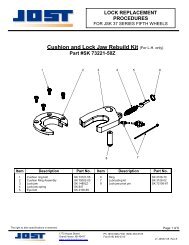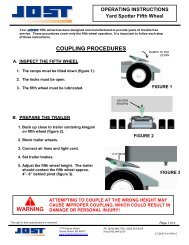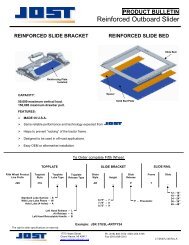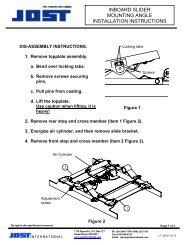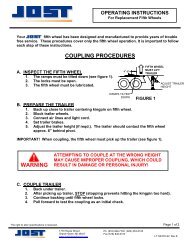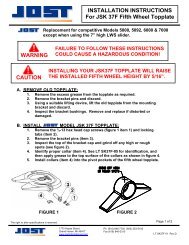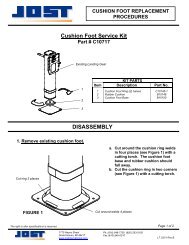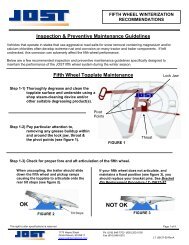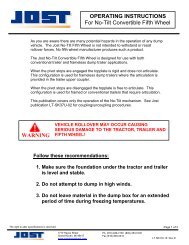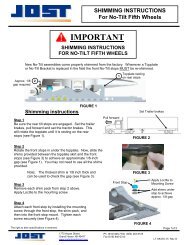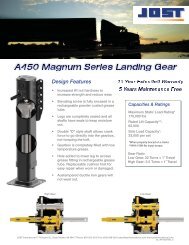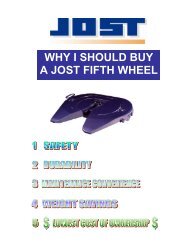maintenance procedures for landing gear - JOST International
maintenance procedures for landing gear - JOST International
maintenance procedures for landing gear - JOST International
You also want an ePaper? Increase the reach of your titles
YUMPU automatically turns print PDFs into web optimized ePapers that Google loves.
IMPORTANT: All steps in this document must be per<strong>for</strong>med at least every 3 months.<br />
STEP 1: INSPECT LEGS AND MOUNTINGS:<br />
Inspection Possible Causes<br />
Cross shaft connection bolts and lock nuts must be<br />
secure, but allow side-to-side play in the cross shaft.<br />
Tighten or replace bolts as necessary.<br />
Inspect the mounting bracket <strong>for</strong> cracks or other signs<br />
of damage.<br />
Repair or replace any broken or damaged parts of the<br />
<strong>landing</strong> <strong>gear</strong> assembly.<br />
Extend the legs and, using a straightedge, inspect <strong>for</strong><br />
bent lower leg and damaged footwear.<br />
Check <strong>for</strong> interference between powder metal bushing<br />
and trailer mounting surface.<br />
Inspect the crank handle bolt and lock nut. Tighten or<br />
replace as necessary.<br />
Check <strong>for</strong> proper crank shaft shifting in both high and<br />
low <strong>gear</strong>.<br />
Important: Landing <strong>gear</strong> with excessive play should be rebuilt or replaced.<br />
STEP 2: INSPECT ALIGNMENT:<br />
The right to alter specifications is reserved.<br />
1770 Hayes Street<br />
Grand Haven, MI 49417<br />
www.jostinternational.com<br />
1. Cross shaft bolt too tight<br />
2. Incorrect cross shaft length<br />
1. Bolts not tightened to proper torque<br />
2. Improper coupling <strong>procedures</strong><br />
1. Overloading<br />
2. Improper coupling techniques<br />
1. Legs not fully retracted<br />
2. Overloading<br />
Inspection Possible Causes<br />
Using a square, check that both legs are square to the<br />
trailer and parallel with each other as shown.<br />
TRAILER END<br />
VIEW<br />
SQUARE<br />
MAINTENANCE PROCEDURES<br />
FOR LANDING GEAR<br />
1. Legs not fully retracted when moving trailer<br />
2. Improper ground clearance<br />
3. Improper coupling <strong>procedures</strong><br />
Holes too small or in incorrect location on<br />
mounting<br />
Crank handle bolt too tight (the crank handle bolt<br />
must be loose enough to allow free engagement)<br />
1. Improper installation<br />
2. Loose bracing bolts<br />
3. Improper coupling techniques<br />
TRAILER<br />
SIDE VIEW<br />
SQUARE<br />
Ph. (616) 846-7700 (800) 253-5105<br />
Fax (616) 846-0310<br />
Page 1 of 4<br />
LT LG400-08 Rev.C
STEP 3: INSPECT FOR PROPER OPERATION:<br />
Action Inspection (Look <strong>for</strong> the following damage indicators: Possible Causes<br />
1. Shift to high <strong>gear</strong><br />
2. Extend leg to the ground<br />
3. Inspect <strong>for</strong> smooth operation<br />
4. Position leg approx. 1” from the ground.<br />
5. Place a pry-bar under the foot.<br />
6. Move the leg up and down.<br />
7. Extend leg to the ground<br />
8. Shift to low <strong>gear</strong><br />
9. Crank an additional 8 to 10 turns<br />
If any of the above indicators are present the <strong>landing</strong> <strong>gear</strong> should be disassembled<br />
and inspected <strong>for</strong> actual wear and/or damage. Replace as required.<br />
TRAILER<br />
Note: Both inside and outside mounts crank the same.<br />
The right to alter specifications is reserved.<br />
FIGURE 1<br />
Lower leg wobbling or twisting.<br />
Lower leg makes a sudden drop (hopping).<br />
1770 Hayes Street<br />
Grand Haven, MI 49417<br />
www.jostinternational.com<br />
MAINTENANCE PROCEDURES<br />
FOR LANDING GEAR<br />
Inconsistent torque at different positions the crank<br />
handle throughout the travel.<br />
Without load in high <strong>gear</strong> the torque should not<br />
exceed<br />
9 ft-lbs (approx. 7 ½ lbs at the crank handle).<br />
The vertical leg movement should not exceed 3/16”.<br />
With an empty trailer in low <strong>gear</strong> the torque should not<br />
exceed 22 ft-lbs<br />
(approx. 19 lbs at the crank handle).<br />
RETRACT<br />
LOW<br />
HIGH<br />
EXTEND<br />
Push crank handle in <strong>for</strong> high <strong>gear</strong>.<br />
Pull crank handle out <strong>for</strong> low <strong>gear</strong>.<br />
Turn crank:<br />
Counterclockwise - Retract<br />
Clockwise - Extend<br />
Ph. (616) 846-7700 (800) 253-5105<br />
Fax (616) 846-0310<br />
1. Bent leg<br />
2. Bent lift screw<br />
Damage to lift<br />
screw threads<br />
Bent screw<br />
Damage to lift<br />
screw or lift nut.<br />
Damage to lift<br />
screw threads<br />
Page 2 of 4<br />
LT LG400-08 Rev.C
STEP 4: INSPECT FOR CORROSION:<br />
Vehicle components are getting over exposed to road salts due to the very corrosive<br />
melting agents being used on the roads.<br />
Action:<br />
1. Remove the cross shaft<br />
2. Turn each leg by hand to find out if one or both legs are exhibiting the problem.<br />
3. Determine the best solution by using the chart below.<br />
Inspection (Corrosion indicators): Suggested Solution<br />
If torque is 9 ft-lbs or less Re-lubricate as described in Step 5<br />
1. If torque is between 10-20 ft-lbs<br />
2. The grease is NOT rusty brown<br />
1. If torque is between 10-20 ft-lbs<br />
2. The grease IS rusty brown<br />
If the Leg is completely seized<br />
The right to alter specifications is reserved.<br />
1770 Hayes Street<br />
Grand Haven, MI 49417<br />
www.jostinternational.com<br />
MAINTENANCE PROCEDURES<br />
FOR LANDING GEAR<br />
1. Remove the leg cover<br />
2. Push the grease away from the screw<br />
3. Pour 2-3 oz of 90-180 weight <strong>gear</strong> lube as close to<br />
the screw as possible<br />
4. Let the leg stand over night<br />
5. Run the legs up and down to break any rust loose<br />
6. Re-lubricate as outlined in Step 5<br />
1. Remove the leg cover<br />
2. Push the grease away from the screw<br />
3. Pour 2-3 oz of 10W30 motor oil as close to the<br />
screw as possible<br />
4. Let the leg stand over night<br />
5. Run the legs up and down to break any rust loose<br />
6. Re-lubricate as outlined in Step 5<br />
1. Remove the bottom “drive fit” grease fitting by<br />
clamping w/vise grip pliers and moving up and<br />
down and side-to-side while pulling<br />
2. Spray Kroil or PB Blaster penetrating oil into the<br />
grease fitting hole. Direct the spray toward the<br />
screw <strong>for</strong> 30 seconds<br />
3. Let the leg stand over night<br />
4. Put the <strong>landing</strong> <strong>gear</strong> in low <strong>gear</strong> and extend and<br />
retract the legs to break them free<br />
5. Re-lubricate as outlined in Step 5<br />
Ph. (616) 846-7700 (800) 253-5105<br />
Fax (616) 846-0310<br />
Page 3 of 4<br />
LT LG400-08 Rev.C
STEP 5: LUBRICATE:<br />
The only solution <strong>for</strong> corrosion problems is regular re-lubing of the legs in both the <strong>gear</strong>box (upper<br />
grease zerk) and the screw/nut cavity (lower grease zerk). This action will place a fresh coat of grease<br />
on all the surfaces protecting them from rust.<br />
a) Lubricate at least every 3 months and more frequently in applications where the <strong>landing</strong> <strong>gear</strong> are exposed to excessive<br />
moisture, water spray, dust, or if they are not used <strong>for</strong> extended periods.<br />
b) Lubricate with the trailer securely coupled to a tractor (see coupling instructions Jost publication LT LG400-01).<br />
c) Employ a lubricant compatible with the original type of grease used:<br />
Standard – Lithium base 1-2% Moly EP-2<br />
Low temperature – Arctic-grade, all weather white grease<br />
Lubrication Instructions:<br />
Fully retract the <strong>landing</strong> <strong>gear</strong>, then using high<br />
<strong>gear</strong> extend 7 turns.<br />
Lubricate through the grease fittings as shown.<br />
At least 4oz. at each fitting.<br />
Extend and retract the <strong>landing</strong> <strong>gear</strong> to apply<br />
grease to the entire length of the screw.<br />
TROUBLE-SHOOTING POINTS<br />
Problem Cause Correction<br />
Hard to crank<br />
<strong>landing</strong> <strong>gear</strong><br />
Shaft turns but legs<br />
do not operate<br />
Shaft does not turn<br />
Crank shaft skips<br />
when cranking<br />
1. Turning crank in wrong direction.<br />
2. Attempting to raise or lower trailer in high <strong>gear</strong>.<br />
3. Legs are already fully extended or retracted.<br />
4. Cross shaft binding:<br />
- over-tightened bolts.<br />
- cross shaft bent or too long.<br />
5. Mis-aligned <strong>landing</strong> <strong>gear</strong> legs.<br />
6. Lack of grease.<br />
7. Damaged lift screw or lift nut.<br />
8. Interference between powder metal bushing and<br />
trailer mounting surface.<br />
1. Broken shaft or shaft bolt.<br />
2. Broken pinion <strong>gear</strong> or bevel <strong>gear</strong> or <strong>gear</strong> pins.<br />
1. Broken <strong>gear</strong> teeth.<br />
2. Damaged lift screw.<br />
3. Seized lift screw or nut<br />
4. Bent inner or outer leg tube.<br />
1. Broken <strong>gear</strong> teeth.<br />
The right to alter specifications is reserved.<br />
1770 Hayes Street<br />
Grand Haven, MI 49417<br />
www.jostinternational.com<br />
MAINTENANCE PROCEDURES<br />
FOR LANDING GEAR<br />
BEVEL GEARS<br />
(Add 4oz. Every 3 mo.)<br />
LIFT SCREW/NUT<br />
(Add 4oz. Every 3 mo.)<br />
Warning: Do not use any lubricants<br />
containing Teflon<br />
7 turns in<br />
high <strong>gear</strong><br />
1. See below <strong>for</strong> proper crank handle rotation.<br />
2. Shift to low <strong>gear</strong> (see figure 1). DO NOT ATTEMPT TO LIFT OR<br />
LOWER IN HIGH GEAR.<br />
3. Turn crank in opposite direction to retract or extend.<br />
4. Inspect cross shaft bolts. Back off bolts to allow lateral (side-to-side)<br />
movement of cross shaft. Use self-locking type nuts only.<br />
5. Legs must be parallel and extend and retract evenly. Remove cross<br />
shaft; adjust <strong>landing</strong> <strong>gear</strong> legs to same height.<br />
6. Grease <strong>landing</strong> <strong>gear</strong> as directed above (Maintenance Procedures).<br />
7. Check <strong>landing</strong> <strong>gear</strong> <strong>for</strong> signs of impact (accident) damage.<br />
Disconnect cross shaft and crank legs individually to determine which<br />
leg is damaged. Replace damaged leg.<br />
8. Hole in trailer mounting surface may need to be enlarged.<br />
1. Replace broken bolt(s) and shaft as needed.<br />
2. Replace broken <strong>gear</strong>(s) or pin.<br />
1. Replace broken <strong>gear</strong>(s).<br />
2. Replace inner leg or entire <strong>landing</strong> <strong>gear</strong> leg.<br />
3. Replace inner leg or entire <strong>landing</strong> <strong>gear</strong> leg.<br />
4. Replace bent inner leg or outer leg, or entire <strong>landing</strong> <strong>gear</strong> leg.<br />
1. Replace broken <strong>gear</strong>(s).<br />
Ph. (616) 846-7700 (800) 253-5105<br />
Fax (616) 846-0310<br />
Page 4 of 4<br />
LT LG400-08 Rev.C<br />
Lift Nut



